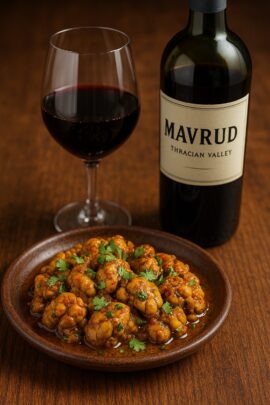Introduction
Goat Brain Fry—rich, spicy, and texturally unique—is a dish that stirs both intrigue and passion. Often enjoyed in South Asian households and street food joints, this delicacy blends silky organ meat with a riot of spices. While traditional pairings include flatbreads or rice, adventurous palates are discovering how wine can elevate its complex profile.
Dish Name & Cultural Context
Dish Name: Goat Brain Fry (Bheja Fry)
Cultural Context: A prized dish in Mughlai and South Indian cuisines, goat brain fry has long held cultural significance. Considered a delicacy, it is often prepared on festive occasions or as a specialty street food in cities like Hyderabad, Lucknow, and Chennai. It’s known for its creamy interior, quick stir-frying technique, and intense spice layers.
Key Ingredients & Preparation Style
- Goat brain (cleaned and poached)
- Onion, garlic, ginger
- Green chilies, red chili powder, turmeric
- Garam masala or whole spices
- Fresh herbs (cilantro, mint)
- Ghee or oil
Preparation: The goat brain is first gently boiled to firm it up, then sautéed in a spice-laden base until golden, aromatic, and slightly crisp at the edges.
Flavor & Texture Profile
- Texture: Silky, custard-like interior with crispy exterior bits
- Flavor: Earthy, meaty richness balanced with chili heat, fresh herbs, and warm spices
- Dominant Tastes: Umami, spicy heat, faint sweetness from onions, and pungency from garlic and ginger
Science Behind Spice & Wine Interactions
- Spice & Alcohol: High alcohol wines intensify heat—best to avoid.
- Acidity: Balances the richness of brain and cuts through ghee.
- Tannins: Low to moderate tannins are ideal. High tannins + spice = bitter clash.
- Sweetness: Off-dry or fruit-forward wines soothe spice burn.
- Spice Compounds: Capsaicin (from chilies) and sulfurous elements (from organ meat) call for clean, expressive wines.
Ideal Wine Pairings: Science & Art of Selection
White Wines
- Gewürztraminer (Alsace, France)
Why it Works: Aromatic intensity complements garam masala; off-dry finish cools heat.
Regions/Producers to Try: Domaine Weinbach, Trimbach - Viognier (Barossa Valley, Australia)
Why it Works: Lush stone fruit, florals, and moderate acidity match the dish’s complexity.
Regions/Producers to Try: Yalumba, Torbreck - Dimyat (Black Sea Coast, Bulgaria)
Why it Works: A light-bodied white with floral and citrus notes that freshen the palate.
Regions/Producers to Try: Domaine Boyar, Edoardo Miroglio
Red Wines
- Pinot Noir (Burgundy, France)
Why it Works: Low tannins, bright acidity, and earthy tones complement the brain’s richness.
Regions/Producers to Try: Joseph Drouhin, Louis Jadot - Grenache (McLaren Vale, Australia)
Why it Works: Juicy red fruit and soft tannins balance the heat and umami.
Regions/Producers to Try: d’Arenberg, Thistledown - Mavrud (Thracian Valley, Bulgaria)
Why it Works: Deep plum flavors and soft spice pair beautifully with Indian seasoning.
Regions/Producers to Try: Zagreus Winery, Villa Melnik
Alternate Wines: Unexpected Pairings
- Sparkling Rosé (France or Australia)
Why it Works: Bubbles lift the dish’s richness; acidity resets the palate; rosé fruitiness calms spice. - Orange Wine (Bulgaria)
Why it Works: Tannic edge from skin contact complements the dish’s structure; oxidative notes resonate with organ meat.
Wines to Avoid & Common Mistakes
| Mismatched Pairing | Why It Doesn’t Work | Better Alternative | Example Wine | Example Reason | Suggested Wine |
|---|---|---|---|---|---|
| Oaked Chardonnay | Too creamy, clashes with spicy heat | Unoaked Viognier | Napa Chardonnay | Heavy oak + spice = harsh finish | Barossa Viognier |
| High-Tannin Cab Sauvignon | Overpowers delicate texture and intensifies spice | Light Pinot Noir | Bordeaux Blend | Too bold for soft texture | Burgundy Pinot Noir |
| Bone-Dry Riesling | Acid too high without fruit to balance spice | Off-Dry Gewürztraminer | Trocken Riesling | Too sharp and lean | Alsace Gewürztraminer |
Final Thoughts & Expert Tips
- Key Takeaway: Balance spice with gentle acidity and avoid heavy tannins or high alcohol.
- Fun Fact: In Hyderabad, goat brain fry is often served for breakfast after early morning prayers during Ramadan.
- Personal Pairing Tip: Serve Grenache slightly chilled for a vibrant, red-fruited contrast to the savory fry.
Recipe & Wine-Friendly Adjustments
Ingredients
- 2 goat brains
- 1 onion, finely chopped
- 2 green chilies, sliced
- 1 tsp ginger-garlic paste
- ½ tsp turmeric
- 1 tsp chili powder
- ½ tsp garam masala
- Fresh cilantro
- 2 tbsp ghee or oil
- Salt to taste
Preparation
- Rinse and boil brains gently for 5–7 minutes in salted water. Drain and pat dry.
- In a pan, heat ghee. Sauté onions, green chilies, and ginger-garlic paste.
- Add turmeric, chili powder, salt, and garam masala. Cook until aromatic.
- Gently fold in brains; break slightly to absorb flavors. Fry until edges crisp.
- Garnish with fresh cilantro and a squeeze of lime.
Wine-Friendly Modifications
- Reduce chili heat by half for more sensitive palates.
- Add a spoon of yogurt for creamy acidity and wine synergy.
- Serve with a wedge of lime to bridge citrus notes in wine.
Serving Suggestions
- Pair with soft rotis or buttered toast.
- Plate with roasted cumin potatoes or a mild cucumber raita to cool the palate.
- Serve wine lightly chilled (especially reds like Grenache or Mavrud) to enhance refreshment.


